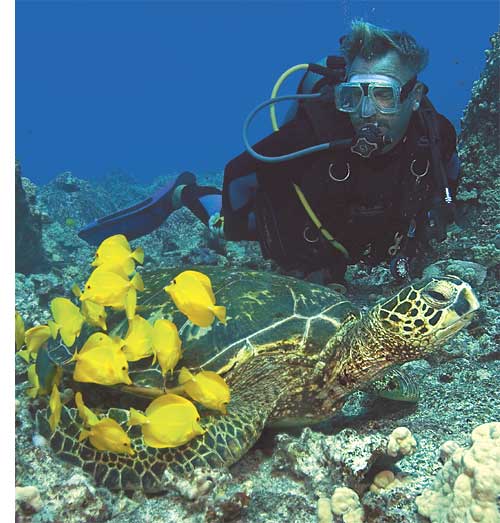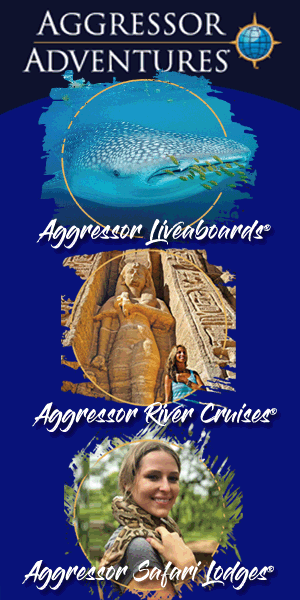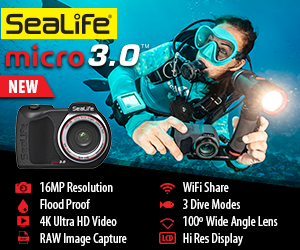 At first all I could see was a tightly packed ball of yellow and brown tangs swarming over what I thought was the seafloor. But as I approached I realized the fish were gathered around a large green sea turtle that was resting on the reef. The tangs were joined by a variety of wrasses and surgeonfishes. All were nibbling away, cleaning the turtle’s shell by removing pieces of algae and other debris. Creeping in ever so slowly I was able to hover over the reef only a yard (1 m) or so away from the action and capture the scene with my camera. It was a classic Hawaiian diving moment.
At first all I could see was a tightly packed ball of yellow and brown tangs swarming over what I thought was the seafloor. But as I approached I realized the fish were gathered around a large green sea turtle that was resting on the reef. The tangs were joined by a variety of wrasses and surgeonfishes. All were nibbling away, cleaning the turtle’s shell by removing pieces of algae and other debris. Creeping in ever so slowly I was able to hover over the reef only a yard (1 m) or so away from the action and capture the scene with my camera. It was a classic Hawaiian diving moment.
Hawaiian waters are well-known for offering wonderful encounters with sea turtles and migrating whales, and cathedral-like lava tubes packed with colorful schooling fishes.
If that isn’t enough, you can explore wrecks or dive with feeding manta rays at night. In many respects, with creatures that range in size from bizarre-looking, colorful shrimps to humpback whales, there is no end to what Hawaiian waters offer divers.
Volcanic Origins
Hawaii is the “loveliest fleet of islands that lies anchored in any ocean.” Those are the words of the 19th century American author Mark Twain. For those who have experienced Hawaii, Twain’s description seems indisputable. From land, sea or air, whether underwater or topside, Hawaii presents one jaw-dropping view after another. Hawaii is varied, rugged yet inviting, lush, elegant, colorful and majestic. From flat calm turquoise seas to towering waves and crashing surf, from sandy beaches and picturesque coves to snow-capped peaks, from lush tropical forests to expansive open fields, from lava beds to stunningly beautiful flowers and waterfalls, and from cloudless skies to double rainbows, Hawaii’s sights, sounds and fragrances are unique and unforgettable.
Any discussion about the geology of Hawaii centers on volcanoes. The islands of the Hawaiian archipelago are actually the peaks of massive shield volcanoes that formed during the past 6 million years. While that might sound like a long time ago to mere humans, in terms of geological time, the islands are relatively young. In fact, the 15 volcanoes that comprise the eight main Hawaiian Islands are the youngest in a chain of about 125 volcanoes that stretch for about 3,600 miles (5,760 km) across the vastness of the Pacific Ocean. Two of the world’s most active volcanoes, Muana Loa and Kilauea, both on the Big Island, continue to add to the island’s landmass.
The peak of Mauna Kea rises to an astonishing height of 33,476 feet (10,144 m) above the floor of the Pacific Ocean, making it the tallest mountain on Earth. The height of a mountain is usually measured from sea level, but when measured from base to peak, Mauna Kea eclipses Mount Everest by more than 4,000 feet (1,200 m).
Hawaii’s Biogeography
Geography has played a fundamental role in shaping Hawaii’s natural world. In terms of the terrain, habitats and climatic zones, Hawaii demonstrates extraordinary diversity. Hawaii is the most isolated island group in the world, and this extreme isolation has made it difficult for terrestrial plants and animals to colonize the islands. The same is true about establishing reproductive populations for species that had to arrive by air or sea because Hawaii is essentially in the “middle of nowhere.” Until recently, when people from foreign lands began to introduce species of plants and animals, all of Hawaii’s diverse population of plants and animals were descendants of successful colonizers.
Many species of marine animals found in other parts of the tropical Pacific are absent from Hawaiian waters. In that respect it is accurate to think of Hawaii as being somewhat species poor. On the other hand, about 23 percent of the fishes found in Hawaii are found only in Hawaii. The same is true of many species of invertebrates, and this helps explain why so many divers are so captivated by Hawaiian diving.
While Hawaii is certainly isolated, it also holds one of the most concentrated collections of ecosystems and climates on Earth with coastal deserts, snow-capped peaks, lush rain forests, alpine lakes and some of the wettest spots on the planet. This diversity has provided Hawaii’s plants and animals with the opportunity to adapt to varying ecosystems.
The People and Their History
While the origin of Hawaii’s earliest settlers remains unproven, most authorities agree that Polynesians migrating throughout the Pacific in sailing canoes were likely the islands’ first inhabitants. The Polynesian migration probably originated from the isles of Fiji, Tonga and Samoa.
Evidence strongly suggests that early Hawaiian visitors arrived in two waves. Somewhere in the neighborhood of the fourth or fifth century the first Marquesans, people from far eastern Polynesia, first arrived in Hawaii. For about 500 years the descendants of the Marquesans lived peacefully in their new land. However, sometime around A.D. 1200 the Tahitians arrived and they subjugated the population. The customs, legends and language of the new arrivals became the mainstays of a new Hawaiian way of life.
In the time after the Tahitian way of life became dominant but before the arrival of Caucasians in the late 18th century, traditional Hawaiian society was distinguished by a rather complex religious, governmental and cultural system that reflected the harmonious relationship the people had with the natural world. The body of laws that governed Hawaiian society at that time was known as kapu, and the kapu system outlined activities and actions that were appropriate and inappropriate for people of different ranks within society.
The kapu system divided Hawaiian society into four groups, the chiefs, priests and craftsmen, commoners, and outcasts. Possessing the power of life or death over those in their domain, the chiefs ruled territories, holding their positions according to family ties and leadership capabilities. One’s rank as a chief was determined by the mother’s lineage, meaning Hawaii was a matriarchal society, and the highest chiefs were treated as gods. Priests and craftsmen performed important religious ceremonies and served as close advisers to the chiefs. Commoners, the largest group, raised, stored and prepared food, built houses and canoes, paid taxes to the chiefs, served as soldiers when necessary, and carried out many daily tasks. The outcasts were segregated from the rest of society. The kapu system also addressed the use, protection and conservation of many natural resources.
Early Hawaiians worshipped many gods with the four principal ones being Kane, the god of life; Ku, the god of war; Lono, the god of agriculture; and Kanaloa, the god of the ocean. These gods occurred in many forms. In addition to these higher gods there were dozens of demigods who ruled over the natural world. Among them were Pele, goddess of volcanoes; Hina, goddess of the moon; and Laka, goddess of the hula.
Another fundamental belief in ancient Hawaiian society was that when people died their spirits lived on as guardian spirits to the living. These spirits take on the forms of other living creatures such as sharks, birds, geckos and even some inanimate objects. Acknowledging this belief makes it easy to understand why so many modern-day Hawaiians feel such a strong connection with the natural world.
The Third Wave
By accident, in January 1778 the famous British explorer Captain James Cook and his crew “discovered” Hawaii when they sighted the island of Oahu. The word of Cook’s discovery spread rapidly throughout Europe and America, and soon whalers and traders from many nations including America, England, Russia and France began to appear in Hawaii. Of course, the various representatives from these foreign lands all had self-serving ideas about the value of the Hawaiian island to their homelands.
Of course, the introduction of so many foreigners also brought many new diseases to the islands. It is estimated that when Captain Cook first arrived the population in the islands was in the neighborhood of 500,000, and that by 1875 the native population was less than 50,000.
Hawaii was eventually annexed by the United States in 1898 and in 1959 became the 50th state in the United States.
Hawaiian Diving
Underwater Hawaii offers astonishing variety in its dive sites and marine life. Whether swims through lava tubes, seemingly unlimited visibility or the opportunity to swim eyeball to eyeball with large marine creatures, or simply the chance to enjoy captivating corals and other invertebrates Hawaii has much to offer divers of all experience levels. Hawaii’s isolation, combined with a cold current that sweeps southward from the Bering Strait have established a mix of marine organisms, creating a diving destination unlike any other.
Hawaiian reefs have less than one-third the number of species found in the prolific waters of Indonesia and Papua New Guinea, areas that are near the center of the world’s marine biodiversity. A primary reason that Hawaiian waters are not as species-rich as many other areas in the South Pacific is that many fishes do not remain in a pelagic, larval stage long enough to be carried to the remote reefs of Hawaii by ocean currents before the larvae settle to the seafloor. In other words, many larval fishes leave the water column and take up life in reef communities long before they ever reach Hawaii. Many of those that don’t settle out in shallow reefs perish long before they ever reach Hawaii. The same scenario is true for corals and other invertebrates.
Thus, it should come as no surprise to discover that Hawaiian waters are rich with species such as moray eels, surgeonfishes, butterflyfishes and angelfishes that have long larval stages. By contrast, anemonefishes have rather short larval stages and are absent from Hawaiian waters.
Hawaii’s underwater visibility routinely exceeds 100 feet (30 m). The excellent visibility is not all that surprising considering the proximity of many popularly dived reefs to the clear-blue waters of the open ocean and the dramatic fashion in which the seafloor plummets away from the landmass of the islands.
Year-round water temperature in Hawaii tends to range from the low 70s Fahrenheit (21 degrees Celsius) to the low 80s F (27-28 C). When the water is at its warmest, typical tropical wet suits are all that most divers require. However, when water temperature dips many divers find they require additional exposure protection to dive comfortably.
In addition to its population of endemic species, Hawaiian waters are blessed with abundant populations of creatures commonly seen in other parts of the Pacific such as green sea turtles, manta rays, jacks, snappers, groupers, goatfishes, soldierfishes, cardinalfishes, butterflyfishes, angelfishes and more. Observant divers will often see octopuses, groupers hunting with moray eels, a variety of colorful nudibranchs, shrimps, lobsters, crabs, sea stars and so much more.
Sometimes, when the seas are flat and conditions are favorable Hawaiian dive charter boats take divers out into the blue during their surface interval and let those who want to hop in for a deep-ocean snorkel. It is common to see oceanic whitetip sharks and pods of pilot whales and dolphins. But even if you don’t see another living creature, watching rays of sunlight dance through the water column in the clearest water you will have likely ever seen is enough to provide an unforgettable experience.
There is plenty of great shore diving as well. In many locales you can enjoy swimming through massive lava tubes inhabited by colorful schooling fishes. On sunny days, which in Hawaii means most days, dancing shafts of sunlight often illuminate the lava tubes, creating spectacular settings for underwater photographers.
During winter months the buzz among Hawaiian divers centers on visiting humpback whales. Figuratively speaking, the whales seem to be everywhere. No one can promise an underwater sighting, although they certainly occur, but in many dive sites you will be treated to an underwater serenade of singing whales.
As small as Hawaii might seem, it is far too vast to experience in a single weeklong visit. Each island is unique and has much to offer, and in that respect Hawaii must be visited more than once if you really want to see and experience all there is to enjoy both topside and underwater. The ease of travel and the selection of professional dive and tour operators make Hawaiian adventures readily accessible to all.
If Hawaiian diving suffers from anything it is a lack of accurate information. Some people seem to think of Hawaii as a “stopover on their way to the good diving in other parts of the Pacific.” Those of us who have explored Hawaiian waters are well aware that we can never get enough of what Hawaiian diving has to offer.
Story and Photography by Marty Snyderman
Facts and Figures
Location: Hawaii is the northern point of a vast triangle of Pacific Ocean Islands known as Polynesia. The other two points are Easter Island and New Zealand. The Hawaiian archipelago lies within the tropics in the central portion of the Pacific Ocean about 2,396 miles (3,834 km) southwest of San Francisco. A total of 1,470 miles (2,351 km) north of the equator, Honolulu is 21 degrees 13 minutes north latitude and 156 degrees 56 minutes west longitude.
The Islands: The landmass of the 132 islands in the Hawaiian archipelago consists of eight main islands and 124 islets. The island of Hawaii, often referred to as “the Big Island” is the largest and geologically youngest of the major islands. Heading northwest from the Big Island, the other major islands are Kahoolawe, Maui, Lanai, Molokai, Oahu, home to Honolulu, the capital city, Kauai and Niihau. As the crow flies, Hawaii stretches for about 1,523 miles (2,437 km), making it the world’s longest island chain. The state encompasses 10,932 square miles (28,423 sq km). Of that area, 4,508 square miles (11,721 sq km) are water and 6,423 square miles (16,700 sq km) are land.
Climate: The climate is generally consistent and mild throughout the year with moderate-to-high humidity, northeasterly trade winds, and significant differences in rainfall within rather short distances. At sea level the average daytime summer temperature is 85 degrees F (29 C). The average daytime winter high is 78 F (26 C). Nighttime temperatures are often cool enough to warrant a sweater. Temperatures drop significantly with altitude, and weather is often localized.
Entry Requirements: As a state in the United States, conditions of entry for Americans are the same as they are to cross state lines in the continental United States. For non-U.S. citizens, requirements vary according to whether Hawaii is the first port of entry into the United States or whether one has already legally entered the country and is merely crossing state lines. Some visitors require a visa. However, Canadians only need a passport and citizens of some nations can stay up to 90 days without a visa.
Getting There: Honolulu is an international hub. Many flights from the continental United States and other international destinations go to Honolulu daily and some flights are direct to other islands. Inter-island flights are frequent.
Nondiving Activities: Snorkeling, sailing, fishing, kayaking, hiking, four-wheeling, motorcycling, biking, nature tours, Jet Skiing, windsurfing, surfing, golf, tennis, beachcombing and more. Spas and gyms abound.
Language: English and Hawaiian, which is spoken daily on the private island of Niihau and being taught in schools throughout the state.
Currency: U.S.
Electricity: 110/120v (volt), 60 Hz (hertz)
Time: Greenwich meantime minus 10 hours. Hawaii does not use daylight saving time.





